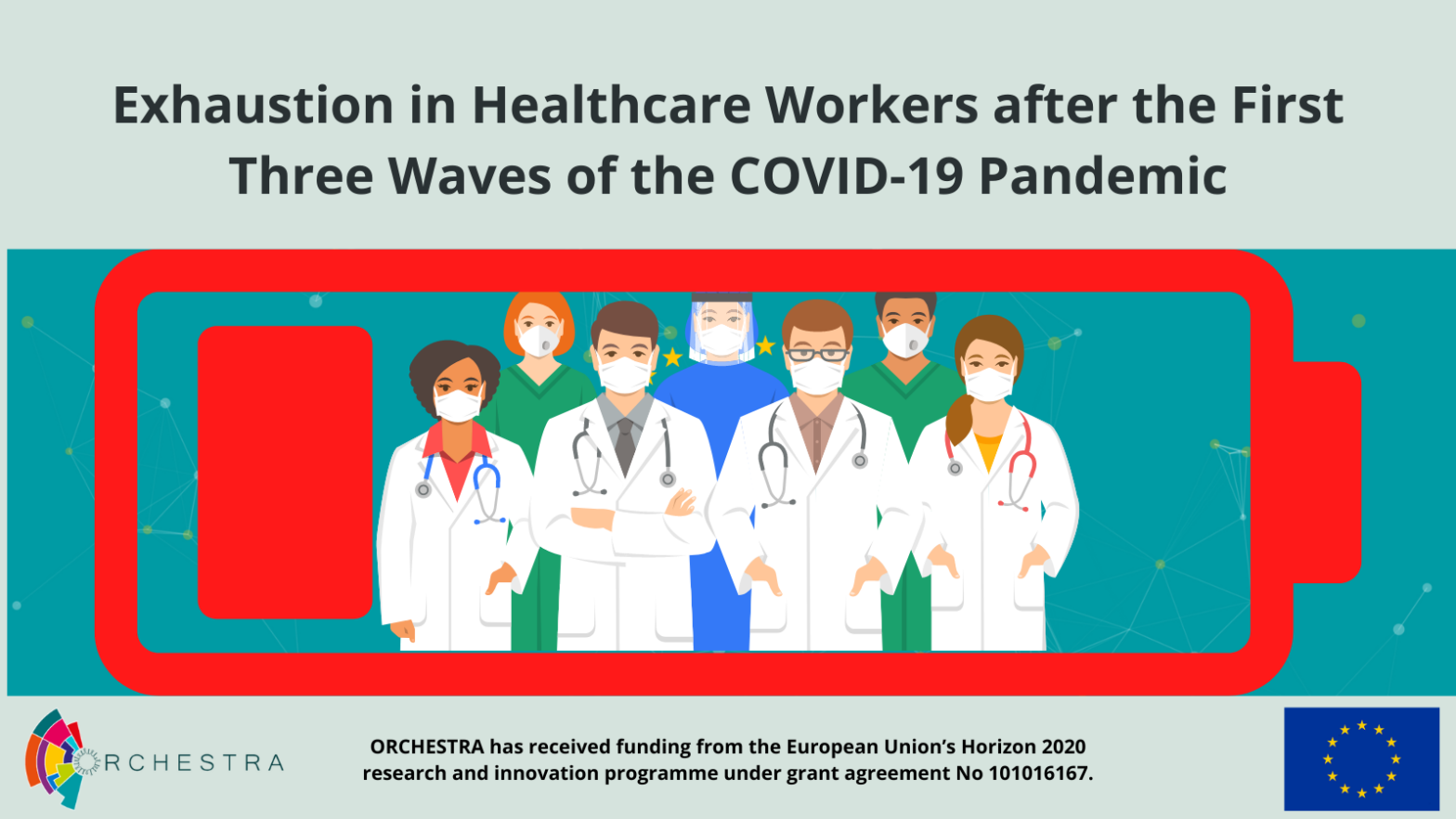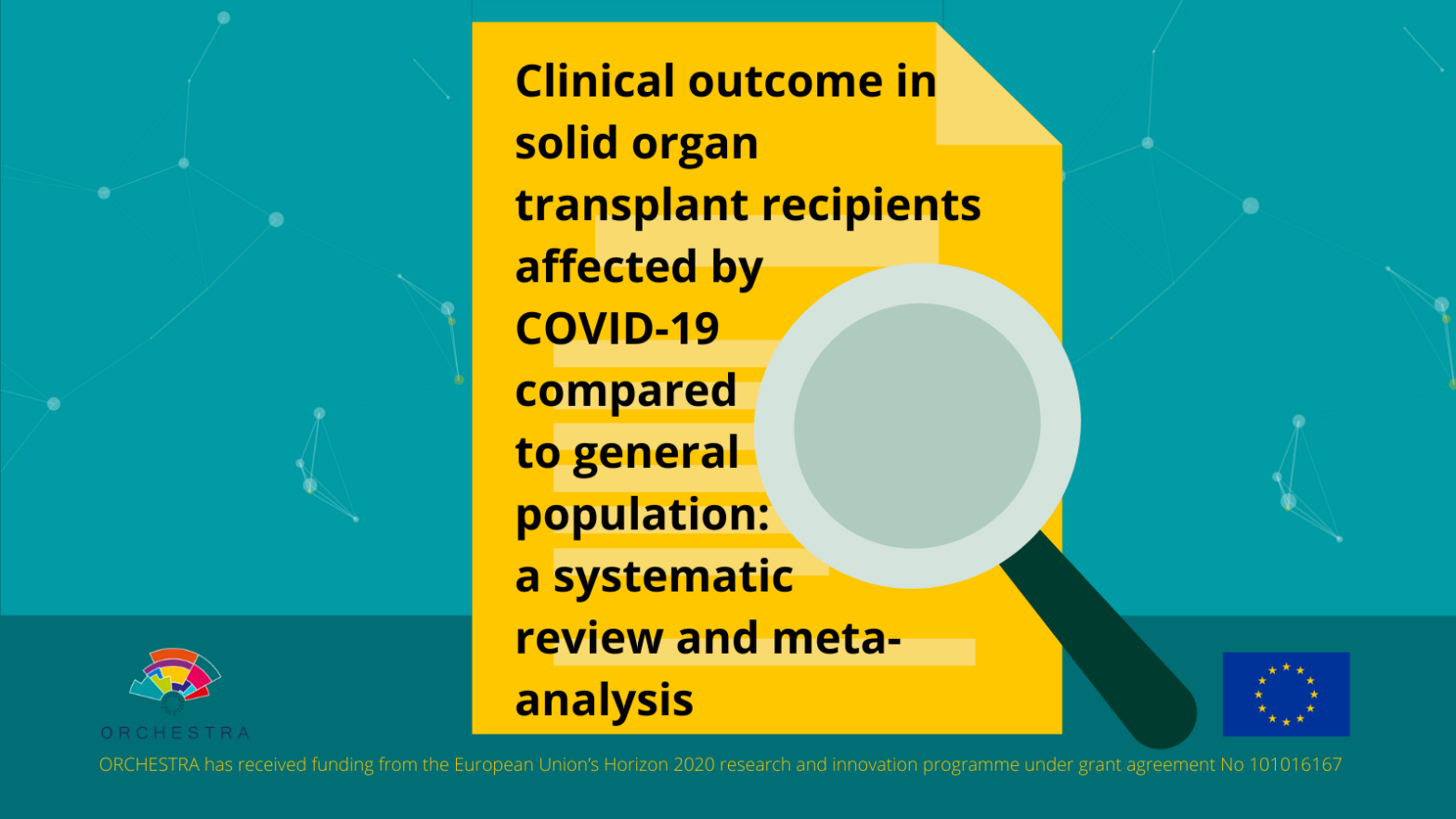Category: Uncategorized
Chemosensory assessment and impact on quality of life in neurosensorial cluster of the post COVID 19 syndrome
E. Gentilotti, A. Gorska, M.P. Cecchini, M. Mirandola et al.
Contributing partner:
CINECA, Italy
Scientific article available at:
“Sci Rep”
Chemosensory assessment and impact on quality of life in neurosensorial cluster of the post COVID 19 syndrome
E. Gentilotti, A. Górska, M. P. Cecchini, et al.
Contributing partner:
UNIVR, Italy
Scientific article available at:
“Scientific Reports”
Exhaustion in Healthcare Workers after the First Three Waves of the COVID-19 Pandemic
Exhaustion in Healthcare Workers after the First Three Waves of the COVID-19 Pandemic
The study examined the most determining causes for exhaustion of frontline and second line healthcare workers (HCW) during the third wave of the COVID-19 pandemic. Responsible ORCHESTRA partner is the National Institute of Public Health (INSP) in Bucharest which contributes to Work Package 5, the Healthcare Workers Cohort.
Prof. Marina Otelea, is one of the authors and explains results and impact.
You used an anonymous questionnaire that was answered by about 1,800 first- and second-line Romanian Healthcare Workers. What was the most significant result that you found?
The most significant finding was that exhaustion was associated in both frontline and second line HCW with overcommitment and a perceived imbalance between effort and reward. Overcommitment, is getting involved in too much work, taking supplementary tasks to prove efficacy; however, it is an ineffective coping strategy to work pressure (work load, unsatisfactory interpersonal relations at work etc.) and not a solution. It is related to neuroticism and low job satisfaction.
Was there a difference in the level of exhaustion in between first row and second row healthcare workers? – There had been previous studies about frontline healthcare workers but this is the first study including second row healthcare workers, right?
There are not many studies comparing these two categories of HCW and the results are quite contradictory. In our study, the frontline HCW had a higher risk of exhaustion, but this risk was not negligible in second line HCW.
In your conclusion you found that front line HCWs were at higher risk for exhaustion than second line HCWs – yet, you found that frontline HCWs “managed better the content”. What do you mean by that?
The International Labour Organization (ILO) defines the content of work in terms of workload, work schedule, task design whereas the work context as organisational culture, role definition, interpersonal relations, carrier evolution. It looked like that, during the third wave, the work content was better re-organized/adapted for the frontline HCW, but still inefficient for the second line ones.
You used the Siegrist Model. What is it about?
The model considers that organisational stress derives from high workload and low reward (recognition of merits, respect, promotion, financial reward).
What kind of questions did you ask?
Questions related to the perceived effort and reward and also to overcommitment attitude (thinking constantly about work, lack of work-life separation etc.). Those questions aimed to investigate the stressors. The effect was the exhaustion, which was assessed with an adapted questionnaire form the initial Maslach questionnaire for burnout.
“The study was conducted in a healthcare system that is still poor according to European standards and covered a large spectrum of occupations in the medical sector, two distinctive characteristics that are approached rather infrequently in publications regarding the negative impact of the current pandemic in HCW [26].”. Do you have any other studies in ORCHESTRA to compare the different situations of HWCs across Europe?
Unfortunately, the other countries have used different measures for exhaustion and other types of influencers.
How can healthcare workers benefit from your study?
First, we have shown that the Siegrist questionnaire (which is free to use) is able to identify those at high risk of exhaustion. Secondly, it looks that the general measures, which were imposed on frontline HCWs were more efficient than the ones (less defined) for the second line HCWs. It also shows that the major responsibility and stress was on doctors, which is different from other countries in which nurses were the most stressed HCWs.
Are there any secondary gains from your study (e.g. can the determents be used for further studies)?
There might be, but we did not mention them in the article as they would be speculative in the strict interpretation of the results. For example, the fact that doctors were reporting the highest exhaustion might be the consequence of the too centralised decision system in the Romanian medical activity, in which nurse have very few autonomy and doctors have the responsibility for everything. It also shows the fear to take initiatives and to change the organisational model without a clear direction from authorities. And maybe the lack of managerial skills in the public healthcare sector.
Marina Otelea, is an Associate Professor in Occupational Medicine, University and Medicine and Pharmacy Carol Davila, Bucharest.
Interview by Marlene Nunnendorf, ORCHESTRA Science Communication Officer.
Please find the original study here: IJERPH
Clinical outcome in solid organ transplant recipients affected by COVID
Clinical outcome in solid organ transplant recipients affected by COVID-19 compared to general population: a systematic review and meta-analysis
The study was carried out through the collaboration of three ORCHESTRA partners, the University of Bologna (UNIBO), the University of Verona (UNIVR) and the Service Andaluz de Salud (SAS), and is one of the systematic reviews developed for Work Package 2, Task 2.2, led by SAS. It was published in Clinical Microbiology and Infection.
Five questions about the research to Maddalena Gianella, leader of Work Package 4, an associate professor at the Department of Medical and Surgical Sciences at the University of Bologna, and who provides the information on behalf of the team of Work Package 2.
What is the purpose of the study?
A significantly increased risk of complications and mortality has been described in immunocompromised patients affected by COVID-19. However, the effects of COVID-19 in solid organ transplant recipients (SOT recipipients) are still debated due to conflicting evidence from various observational studies. We wanted to investigate the evidence and provide clarity on this issue.
What was the method/what has been done to answer the purpose?
We performed a systematic review with meta-analysis to assess the clinical outcome in SOT recipients with COVID-19 compared to the general population. 3,501 articles were screened, and thirty-one observational studies were included in the meta-analyses. We evaluated the data sources PubMed-MEDLINE and Scopus. Both were independently searched until 13 October 2021. The study eligibility criteria (guidelines for who can or cannot participate in the study) were: Prospective or retrospective observational studies comparing clinical outcome in SOT recipients versus general populations affected by COVID-19. Primary endpoint was the 30-day mortality. Participants of the study were patients with confirmed COVID-19 exposure. The assessment of risk of bias was performed according to the ROBINS-I tool for observational studies.
What are the learnings?:
In our primary analysis, which included studies adjusting for confounding factors, we found no difference in the 30-day mortality rates. No evidence of publication bias was reported. Still, we found a higher risk of ICU admission and occurrence of acute kidney injury in SOT recipients.
What is your conclusion?
No increased risk in mortality was found in SOT recipients affected by COVID-19 compared to the general population when adjusted for demographic and clinical features and COVID-19 severity.
What are the benefits for the public? This finding can inform public health in potential complications and clinical course of COVID-19 in SOT patients.
The persistence of symptoms after infection with SARS.
The persistence of symptoms after infection with SARS-CoV-2 can last for many months and has been defined as a clinical entity called Long COVID. Long COVID affects patients with numerous symptoms such as fatigue, headaches, breathing difficulties, difficulty concentrating (“brain fog”), chest pain and many more, which impair daily life. “Determinants of symptom persistence and impact on physical and mental well-being in long COVID: A prospective cohort study” is a study investigating the health status of patients after COVID-19 infection. The University of Verona (Italy) enrolled over 400 patients who were hospitalised or treated at home for COVID-19 and whose symptoms, particularly muscle pain, fatigue and breathing difficulties, persisted for up to 9 months after the acute illness. Physical and psychological well-being was influenced by the duration and number of symptoms, and factors such as ICU hospitalisation and age had an impact favouring Long COVID. Our findings encourage follow-up of patients at risk of Long COVID. The ORCHESTRA project makes an important contribution to the management of patients recovering from SARS-CoV-2 infection by providing outpatient appointments for blood tests, radiological examinations and specialist visits.


